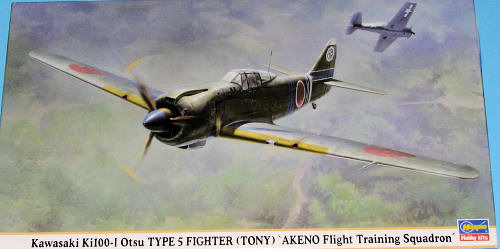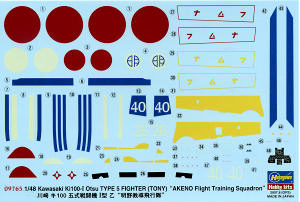
Hasegawa 1/48 Ki-100-I Otsu 'Akeno Flight Training Squadron'
| KIT #: | 09765 |
| PRICE: | I paid $20 in the 'used' kit pile, but I know it is more |
| DECALS: | Three options |
| REVIEWER: | Scott Van Aken |
| NOTES: | Limited reissue (2007) |

| HISTORY |
The kit instructions start off my saying something about the 'highly successful Ki-61'. Well not as highly successful as it could have been. Aside for a nearly non-existant parts supply chain that often grounded perfectly good planes for want of a gasket or spark plugs, the Ki-61's reverse engineered DB.601 was not the most reliable engine around.
When the plane was fully functional, it was very good, but so bad was the engine situation, that by mid 1944 there were scores of completed airframes awaiting power plants. Then, someone got the idea of using a bomber engine. These were 14 cylinder twin row radials that required a major redesign of the nose to properly fit. However, necessity is the mother of invention and in a remarkably short time, the Ki-100 came into being.
Imagine the surprise when it was discovered that this 1500 hp radial completely transformed the plane into an agile and fast aircraft. They couldn't be converted or built fast enough. Unfortunately for the Japanese, the plane only first flew in Feb of 1945, not enough time to get all that many of them into unit service before the war ended 6 months later.
| THE KIT |
 It
will come as a surprise to no one that half of this kit's sprues are for the
Ki-61. Just like the real plane, Hasegawa has added those pieces that will make
it into a Ki-100. This is basically new fuselage halves and the engine section.
the wings, landing gear, interior, canopy, and tailplanes are all standard
Ki-61. And this is good as the Hasegawa 1/48 Ki-61 is a beauty of an aircraft.
Were I not such a lethargic builder, I'd have done a ton of these.
It
will come as a surprise to no one that half of this kit's sprues are for the
Ki-61. Just like the real plane, Hasegawa has added those pieces that will make
it into a Ki-100. This is basically new fuselage halves and the engine section.
the wings, landing gear, interior, canopy, and tailplanes are all standard
Ki-61. And this is good as the Hasegawa 1/48 Ki-61 is a beauty of an aircraft.
Were I not such a lethargic builder, I'd have done a ton of these.
So, let me take another look a things. Seven sprues of which one is clear and offers both canopy types. The detailing is finely engraved and crisply executed. There are the usual ejector pin marks on the gear legs, wheels, inside of gear doors and so on. None impossible to fix, but we wish they weren't there to start. Nicely done cockpit with raised detailing on the instrument panel and a decal if you wish to go that route. Nicely done is the sidewall and the rest of the cockpit parts, needing only a shoulder harness to make for a perfectly acceptable cockpit. One of these days, kit makers will start including this item in all their kits.
Probably the area that will cause any difficulty will be the lower
fuselage section that fits over the lower wing. I have heard that care needs to
be taken to get a good fit. Nothing fancy under the wings, just a pair of pylons
and drop tanks. These could easily be left off and would make for a much cleaner
looking aircraft.

Instructions are par for Hasegawa and have the usual Gunze paint references. Decals are well printed and the colors look right. The sheet includes the yellow wing ID bands, but I'd recommend painting this area instead. Wing walk markings are also included along with the usual insignia and unique markings. Both options are Kawasaki Dark Green over unpainted metal. The lower side of the fabric control surfaces should probably be a grey green color but are shown in the instructions as aluminum. The first option is that of the box art; Major Yohei Hinoki's plane of the Akeno Training Division. This plane has a lot of color in terms of both fuselage and upper wing bands. the other is a more mundane looking plane from the 111th Flight Regiment with only an aluminum tipped spinner and red fin tip to add color.
| CONCLUSIONS |
This aircraft has been released in several other limited issue boxings. Regardless of which you can find, I'd go for it as it is a superb kit.
Many thanks to 'store credit' for bringing this to you.
December 2008 If you would like your product reviewed fairly and quickly, please
contact
me or see other details in the
Note to
Contributors.